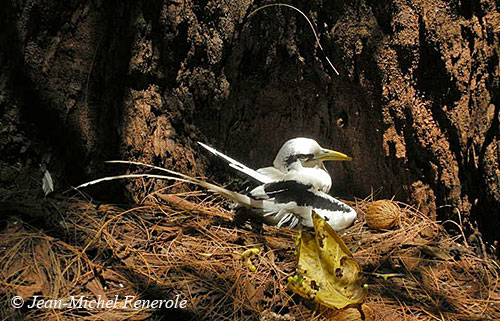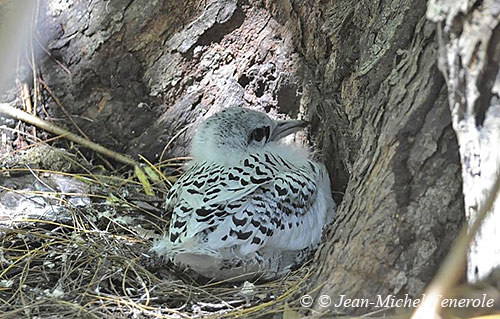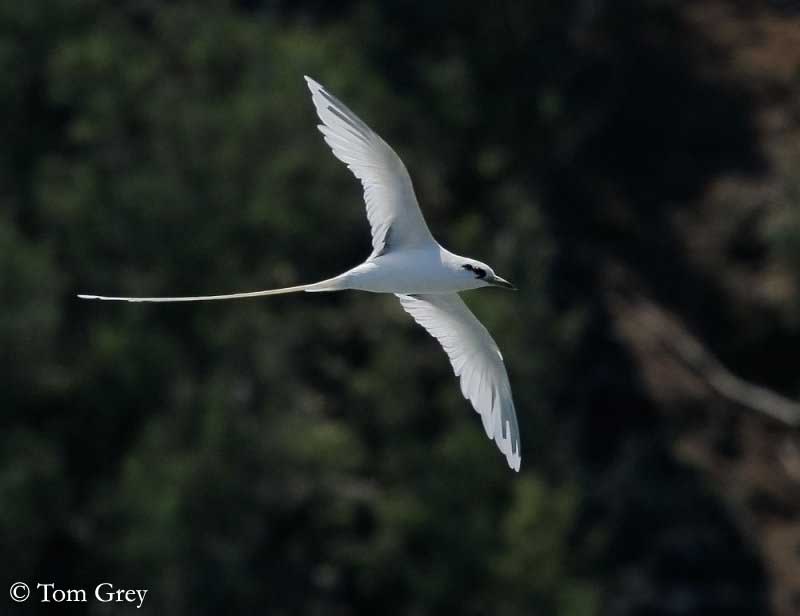
White-tailed Tropicbird
Phaethon lepturus
Phaethontiformes Order – Phaethontidae Family
BIOMETRICS:
Length: 70-82 cm
Wingspan: 90-95 cm
Weight: 220-410 g
LONGEVITY : up to 16 years
DESCRIPTION:
White-tailed Tropicbird is the smallest of the three Tropicbirds. It is locally called “Longtail”, referring to its long tail (about 33 to 45 cm).

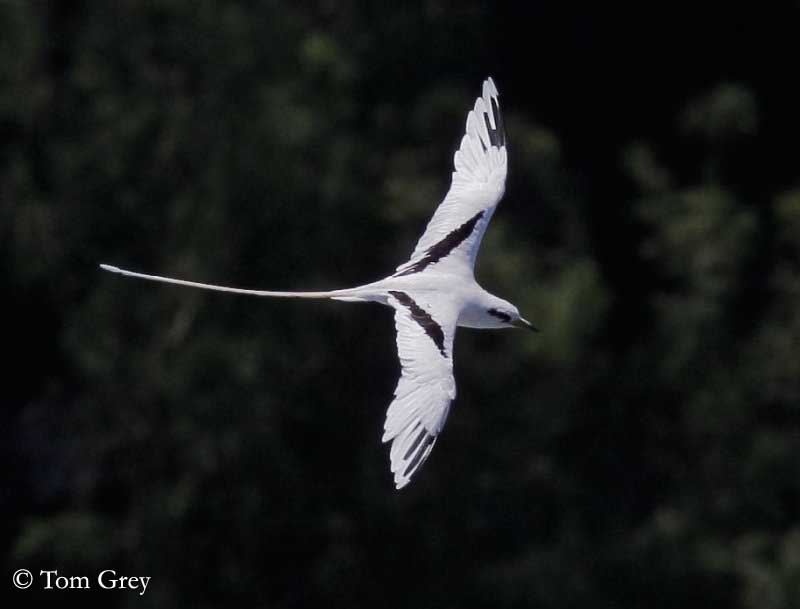
Adult has white plumage overall.
On the upper wings, we can see a black diagonal stripe on inner wings, and black outer primaries. But the extent of black is variable.
Tail is white with long central streamers.
Underparts are pure white.
Head is white, with black eye-line, from lores to ear-coverts. Pointed bill is bright orange-yellow. Eyes are dark brown. Legs and feet are dark grey.
Both sexes are similar.
Juvenile shows coarse black barring on the upperparts, and lacks the tail streamers. It has yellower eyes than adults. It reaches its sexual maturity at four years of age.
We can find six subspecies:
P.l. lepturus (described above) is found in Islands in the Indian Ocean.
P.l. doratheae is found in islands in tropical W Atlantic Ocean (Hawaii to New Caledonia).
P.l. catesbyi breeds in islands in tropical Atlantic Ocean (West Indies – Bermuda).
P.l. ascensionis is found in Fernando de Noronha and Ascension Islands.
P.l. europae is found in Europa Islands (S Mozambique Channel).
P.l. fulvus breeds on Christmas Island (Indian Ocean).
They differ in size and extent of black on outer primaries.
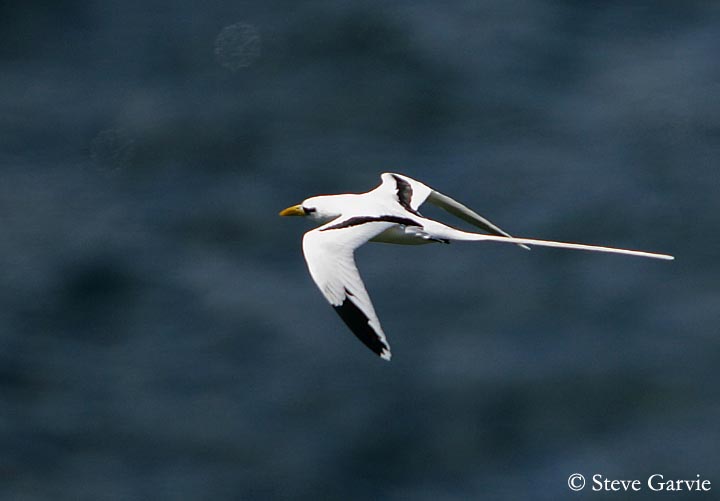
VOICE: SOUNDS BY XENO-CANTO
White-tailed Tropicbird is usually silent away from the breeding colony. It calls mainly when in flight.
Courtship flight displays can be noisy, with strident, repeated calls. It screams loudly at nest if threatened or disturbed.
Soft sounds are uttered by adults when they feed the chicks.
HABITAT:
White-tailed Tropicbird is pelagic, but it may frequent the coast for food. This species breeds on small oceanic islands, on cliffs, and sometimes in fork in tree.

During breeding season, White-tailed Tropicbird performs beautiful flight displays. Both mates fly in parallel and perform aerobatics and synchronised figures. The streamers of the bird which is above are turned downwards, towards the other bird and can even touch it. Both birds perform shallow glides. These flights are very noisy.
White-tailed Tropicbird is resident in its range. Adults and juveniles perform dispersions as much as 1000 km. The birds of the northern parts of the range are migratory.
FLIGHT:
White-tailed Tropicbird performs wonderful flight displays involving aerobatics and glides. During these displays, both mates fly in zigzag, and perform downwards glides, sometimes over several hundreds of metres, with one bird above the other.
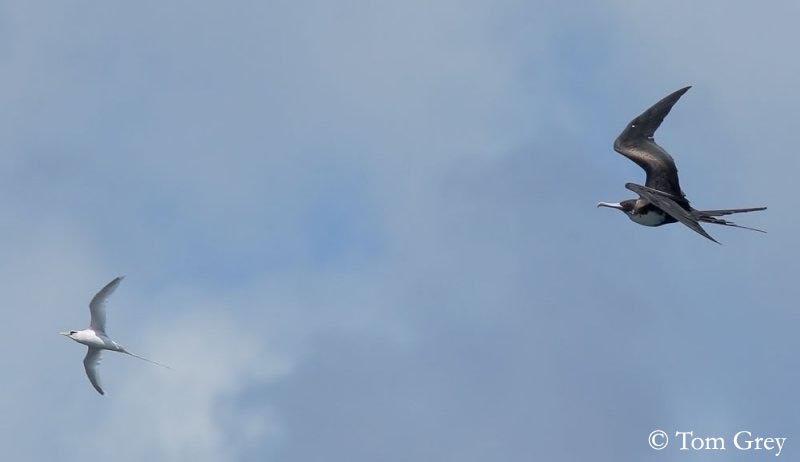
White-tailed Tropicbird defends strongly the nest. The owner pecks at intruder or nearby tropicbird, and their pointed bills often cause injuries on head and neck.
When nesting-site is established, and nest ready, female lays a single egg, very variable in colour and markings. Incubation lasts about 40 to 42 days, shared by both parents which take turns.
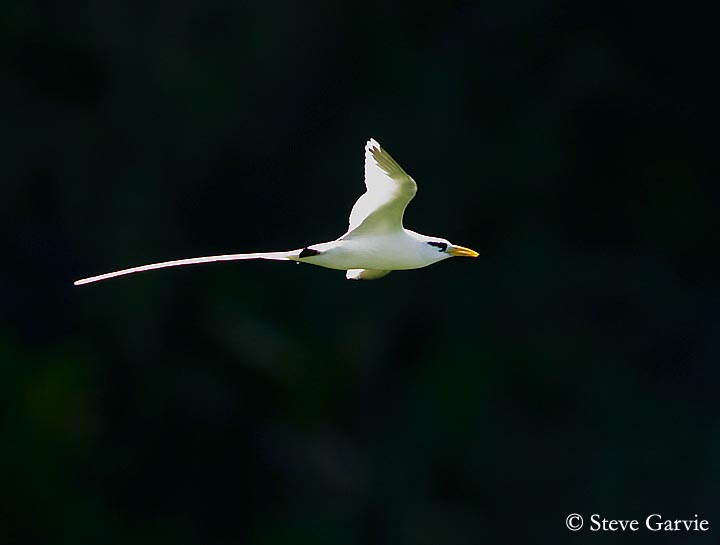
Chick is covered with pale down at hatching. It is continuously brooded during the first days, and then, it remains at nest waiting for adults and food.
It is fed by semi-digested food. Parents regurgitate into the chick’s gullet. The young fledge about 70 to 85 days after hatching, and takes its first flight very quickly. It becomes immediately independent and performs a post-fledging dispersal.
White-tailed Tropicbirds are monogamous and pairs stay together for years. They may reuse the same nest several times, because nest-sites are scarce.
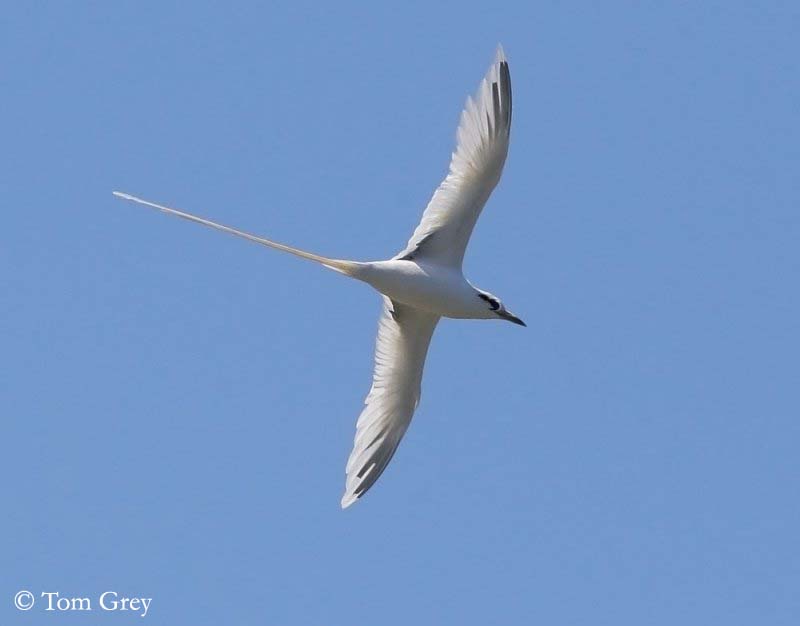
Fr: Phaéton à bec jaune
All : Weißschwanz-Tropikvogel
Esp : Rabijunco Menor
Ital : Fetone beccogiallo
Nd : Witstaartkeerkringvogel
Russe : Белохвостый фаэтон
Sd : Vitstjärtad tropikfågel
Photographers:
Jean Michel Fenerole
Photos d’Oiseaux du monde
Tom Grey
Tom Grey's Bird Pictures
Steve Garvie
RAINBIRDER Photo galleries
Alan & Ann Tate
AA Bird Photography
Text by Nicole Bouglouan
Sources :
HANDBOOK OF THE BIRDS OF THE WORLD vol 1 by Josep del Hoyo-Andrew Elliot-Jordi Sargatal - Lynx Edicions - ISBN: 8487334105
Wikipedia, the free encyclopaedia
CREAGUS@Monterey Bay (Don Roberson)
White-tailed tropicbird (golden bosun)
White-tailed Tropicbird

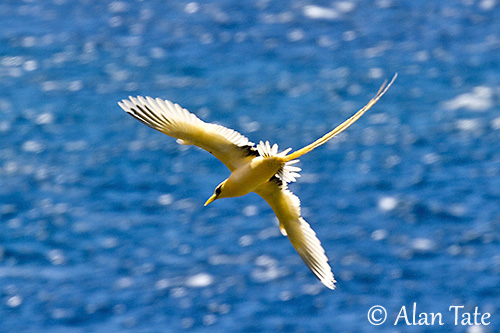
RANGE:
White-tailed Tropicbird occurs in Tropical Atlantic, Western Pacific and Indian Oceans. It breeds on Caribbean islands and northwards in Bermuda.
BEHAVIOUR:
White-tailed Tropicbird feeds on small fish, mainly flying fish, squid and crabs. It catches its preys by diving from height of up to 20 metres, as gannets. However, flying fish is caught in flight.
It usually feeds alone or sometimes in pairs. Prey is often detected by hovering above the surface. White-tailed Tropicbird swallows it before to take off.
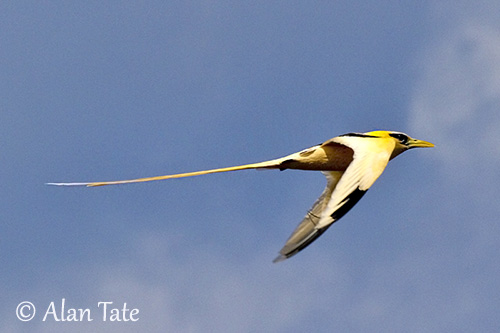
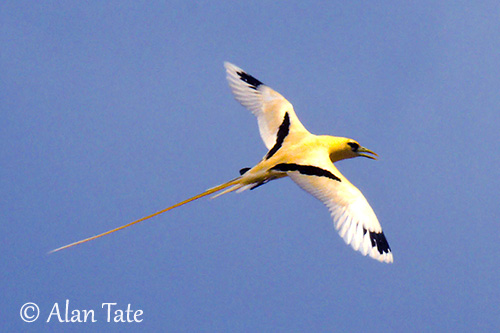
ABOUT PHAETON LEPTURUS FULVUS
Phaethon lepturus fulvus has deep golden-apricot plumage, and is endemic to Christmas.
It is also named Golden Bosun-bird. This race has a strong golden apricot colour and its golden-tinged feathers are reflected in the local name “Golden Bosun-bird”.
The two long central tail feathers used in visual signals during the courtship displays, also act as stabilizers during the most aerobatic aerial manoeuvres. In this race, these long feathers show a very strong orange tinge. Actually, the whole bird appears golden rather than white.
The Golden Bosun-bird breeds exclusively on Christmas Island in the Indian Ocean all year round. The eggs are laid in rock crevices, hollows in rainforest trees, or on bare sandy ground.
It roost at sea and forages over the Indian Ocean. Only the incubating adult remains on the island. It forages at sea by diving into the water to feed on fish and squid.
The Golden Bosun-bird was previously thought to be very rare, but it is mainly difficult to locate while nesting. This race has probably larger numbers than previously thought.
DIET:
White-tailed Tropicbird feeds on small fish, mainly flying fish often caught in flight. It also takes squid and crabs.
PROTECTION / THREATS / STATUS:
White-tailed Tropicbirds are the most numerous of tropicbirds, but some populations, such as in Christmas, have declined due to habitat loss.
Main predators are introduced rats, which take the eggs and kill the birds. Human disturbances also play an important role in some declines.
However, this species is not globally threatened at this moment.
